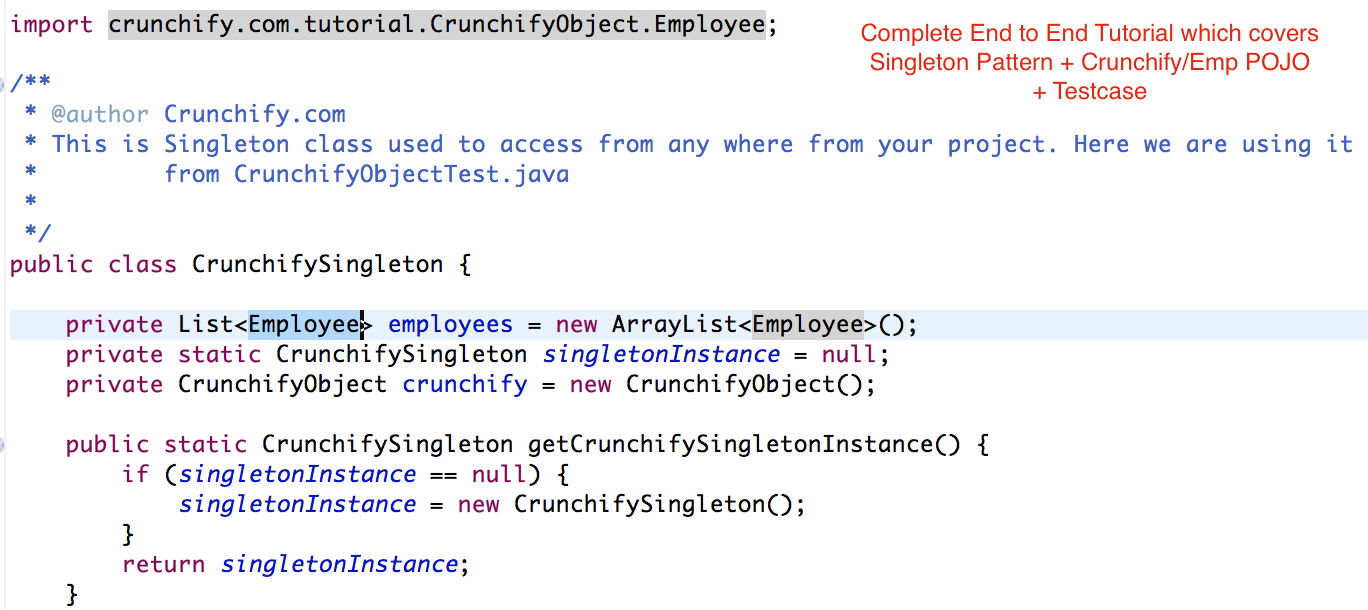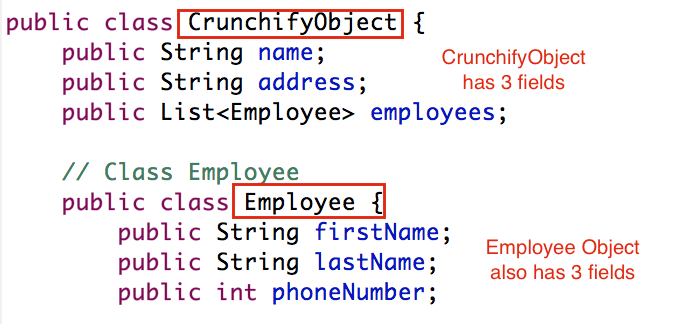أكمل برنامج Java التعليمي من البداية إلى النهاية مع موظف الكائن Singleton ، و Crunchify Java POJO وحالة الاختبار التفصيلية
نشرت: 2014-11-06
في هذا البرنامج التعليمي لـ Java ، سوف نتجاوز جميع الخطوات التفصيلية المطلوبة لك لاستخدام Singleton pattern في مشروع Enterprise الخاص بك. نستخدم كائن Singleton لدفع البيانات المطلوبة في وقت التشغيل ونستخدم نفس كائن Singleton لاسترداد البيانات في وقت التشغيل. يمكنك الوصول إلى كائن Singleton من أي مكان. إذا كنت تريد معرفة المزيد عن نمط Singleton ، فاتبع هذا البرنامج التعليمي Singleton.
هيا بنا نبدأ
الخطوة 1
قم بإنشاء Crunchify Object POJO: CrunchifyObject.java

الخطوة 2
قم بإنشاء جميع أدوات التعيين والحاصل.
الخطوه 3
إنشاء فئة فردية: CrunchifySingleton.java
الخطوة 4
اكتب جميع طرق المنفعة في فئة Singleton
الخطوة 5
أخيرًا ، قم بإنشاء فئة اختبار: CrunchifyObjectTest.java
تحتاج أدناه إلى تبعية JSON:
|
1 2 3 4 5 |
< dependency > < groupId > org . json < / groupId > < artifactId > json < / artifactId > < version > 20151123 < / version > < / dependency > |
CrunchifyObject.java
|
1 2 3 4 5 6 7 8 9 10 11 12 13 14 15 16 17 18 19 20 21 22 23 24 25 26 27 28 29 30 31 32 33 34 35 36 37 38 39 40 41 42 43 44 45 46 47 48 49 50 51 52 53 54 55 56 57 58 59 60 61 62 63 64 65 66 67 68 69 |
package crunchify . com . tutorial ; import java . util . List ; /** * @author Crunchify.com * This is simple CrunchifyObject POJO contains another class "Employee" as a field */ public class CrunchifyObject { public String name ; public String address ; public List <Employee> employees ; public String getName ( ) { return name ; } public void setName ( String name ) { this . name = name ; } public String getAddress ( ) { return address ; } public void setAddress ( String address ) { this . address = address ; } public List <Employee> getEmployees ( ) { return employees ; } public void setEmployees ( List <Employee> employees ) { this . employees = employees ; } // Class Employee public class Employee { public String firstName ; public String lastName ; public int phoneNumber ; public String getFirstName ( ) { return firstName ; } public void setFirstName ( String firstName ) { this . firstName = firstName ; } public String getLastName ( ) { return lastName ; } public void setLastName ( String lastName ) { this . lastName = lastName ; } public int getPhoneNumber ( ) { return phoneNumber ; } public void setPhoneNumber ( int phoneNumber ) { this . phoneNumber = phoneNumber ; } } } |
CrunchifySingleton.java
|
1 2 3 4 5 6 7 8 9 10 11 12 13 14 15 16 17 18 19 20 21 22 23 24 25 26 27 28 29 30 31 32 33 34 35 36 37 38 39 40 41 42 43 44 45 46 47 48 49 50 51 52 53 54 55 56 57 58 59 60 61 62 63 64 65 66 |
package crunchify . com . tutorial ; import java . util . ArrayList ; import java . util . HashMap ; import java . util . List ; import java . util . Map ; import org . json . JSONArray ; import org . json . JSONObject ; import crunchify . com . tutorial . CrunchifyObject . Employee ; /** * @author Crunchify.com * This is Singleton class used to access from any where from your project. Here we are using it * from CrunchifyObjectTest.java * */ public class CrunchifySingleton { private List <Employee> employees = new ArrayList <Employee> ( ) ; private static CrunchifySingleton singletonInstance = null ; private CrunchifyObject crunchify = new CrunchifyObject ( ) ; public static CrunchifySingleton getCrunchifySingletonInstance ( ) { if ( singletonInstance == null ) { singletonInstance = new CrunchifySingleton ( ) ; } return singletonInstance ; } public void addEmployee ( Employee employee ) { synchronized ( employees ) { employees . add ( employee ) ; } } public List <Employee> getEmployee ( ) { return employees ; } public void addCrunchify ( CrunchifyObject crunchify ) { synchronized ( crunchify ) { this . crunchify = crunchify ; } } public String getCrunchifyObject ( ) { JSONObject obj = new JSONObject ( ) ; obj . put ( "name" , crunchify . getName ( ) ) ; obj . put ( "address" , crunchify . getAddress ( ) ) ; JSONArray employeeJson = new JSONArray ( ) ; for ( Employee emp : employees ) { Map < String , String > employeeData = new HashMap < String , String > ( ) ; employeeData . put ( "firstName" , emp . getFirstName ( ) ) ; employeeData . put ( "lastName" , emp . getLastName ( ) ) ; employeeData . put ( "phoneNumber" , emp . getPhoneNumber ( ) + "" ) ; employeeJson . put ( employeeData ) ; } obj . put ( "employees" , employeeJson ) ; return obj . toString ( ) ; } } |

CrunchifyObjectTest.java
|
1 2 3 4 5 6 7 8 9 10 11 12 13 14 15 16 17 18 19 20 21 22 23 24 25 26 27 28 29 30 31 32 33 34 35 36 37 38 39 40 41 42 43 44 45 46 47 48 49 50 51 52 53 54 55 56 57 58 59 60 61 62 |
package crunchify . com . tutorial ; import crunchify . com . tutorial . CrunchifyObject . Employee ; /** * @author Crunchify.com * This is test class used to create all required objects and use Singleton object to push and * retrieve value at runtime. You could use the same singleton object from anywhere in your enterprise project */ public class CrunchifyObjectTest { static CrunchifySingleton instance = CrunchifySingleton . getCrunchifySingletonInstance ( ) ; public static void main ( String [ ] args ) { populateAndSaveDataFromSingletonObject ( ) ; retrieveDataFromSingletonObject ( ) ; } private static void retrieveDataFromSingletonObject ( ) { String result = instance . getCrunchifyObject ( ) ; System . out . println ( result ) ; } private static void populateAndSaveDataFromSingletonObject ( ) { // Create CrunchifyObject CrunchifyObject crunchifyObj = new CrunchifyObject ( ) ; crunchifyObj . setName ( "Crunchify.com" ) ; crunchifyObj . setAddress ( "NYC - US" ) ; // Create Employee1 Employee emp1 = crunchifyObj . new Employee ( ) ; emp1 . setFirstName ( "Mike" ) ; emp1 . setLastName ( "Rose" ) ; emp1 . setPhoneNumber ( 1222222222 ) ; // Create Employee2 Employee emp2 = crunchifyObj . new Employee ( ) ; emp2 . setFirstName ( "app" ) ; emp2 . setLastName ( "shah" ) ; emp2 . setPhoneNumber ( 1333333333 ) ; // Create Employee3 Employee emp3 = crunchifyObj . new Employee ( ) ; emp3 . setFirstName ( "Dexter" ) ; emp3 . setLastName ( "My" ) ; emp3 . setPhoneNumber ( 1444444444 ) ; // Add all Employee Object to CrunchifySingleton object instance . addEmployee ( emp1 ) ; instance . addEmployee ( emp2 ) ; instance . addEmployee ( emp3 ) ; // Add Employees to CrunchifyObject crunchifyObj . setEmployees ( instance . getEmployee ( ) ) ; // Now finally add CrunchifyObject to same CrunchifySingleton object which will use to retrieve all data instance . addCrunchify ( crunchifyObj ) ; } } |
نتيجة:
|
1 2 3 4 5 6 7 8 9 10 11 12 13 14 15 16 17 18 19 20 21 |
{ "address" : "NYC - US" , "name" : "Crunchify.com" , "employees" : [ { "lastName" : "Rose" , "phoneNumber" : "1222222222" , "firstName" : "Mike" } , { "lastName" : "Shah" , "phoneNumber" : "1333333333" , "firstName" : "app" } , { "lastName" : "My" , "phoneNumber" : "1444444444" , "firstName" : "Dexter" } ] } |
